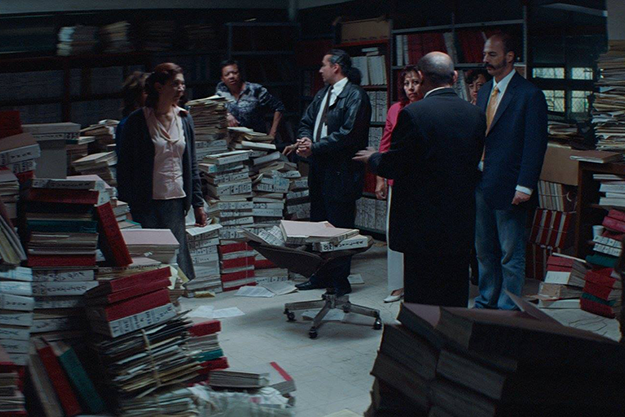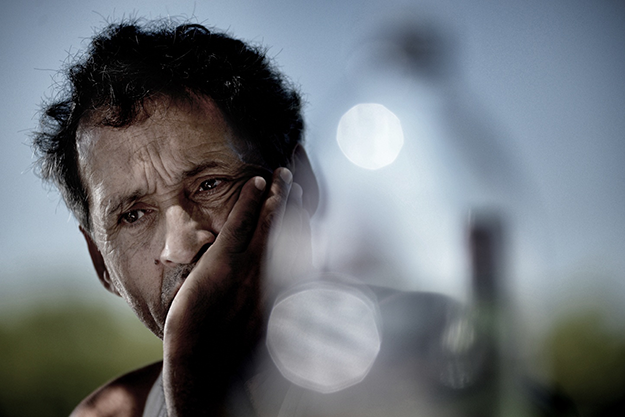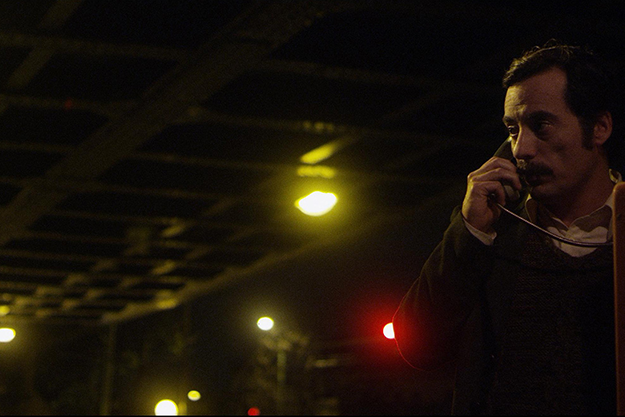Panamerican Machinery (Joaquin del Paso, Mexico) Cut off the head of a snake and the body dies too. Or it may refuse to acknowledge its own decapitation and stubbornly slither on, albeit blind and disoriented. When Don Alejandro, the eccentric millionaire president of Panamerican Machinery, keels over within the first several minutes of Joaquin del Paso’s Panamerican Machinery, his employees find themselves thrust into uncertainty. What ensues is a black comedy that paradoxically retains a light-hearted feel, or, as del Paso put it in an interview with Film Comment, “a comedy that self-destructs.” In this satire of contemporary Mexican politics, and neo-capitalism more broadly, insecurity over adapting to the cutthroat free-market drives Panamerican Machinery’s employees to take the logical next step: they hide Alejandro’s rapidly stiffening corpse and lock themselves in the factory until they can brainstorm a next step. His death poses a special problem because he had been paying their salaries out of pocket. In his absence, company accountant Jesus (Javier Zaragoza) swiftly rises to power, spouting populist-style rhetoric. Jesus, whose charisma belies a thin grasp on reality, is perhaps the least qualified to lead given that his bungling of the company finances is responsible for their current predicament. “I wanted to create this character that is not very smart but is charismatic. And he’s a little bit of a liar. At the end, when I saw him dressed, my costume designer told me, ‘he really looks like a congressman,’” Del Paso said. Jesus does little to stop the increasing factionalization of the workers (including a group of aging men, who take to fashioning themselves as the company rat pack), or the company’s descent into Bacchic debauchery once the mechanics brew up a batch of gasoline toilet wine, lovingly flavored with their dead President’s cologne. A peak inside one of Jesus’ all-important bookkeeping binders reveals columns of numbers scribbled over with cartoon penises. Despite Panamerican Machinery’s dark overtones and political undertones, del Paso infuses the film with enough slapstick-inspired buffoonery to achieve a neat balance of accessibility and abstraction. Viewers may be surprised to find protracted, enigmatic shots lingering over the bodies of hung-over workers that suggest Tarkovsky more than Buñuel. As del Paso put it, “the language and the form of the film is one thing, and then the humor is another thing.” If Panamerican Machinery surveys the intimidating disjuncture between one era of capitalism and another, del Paso’s experiences filming offer evidence enough of the reality of this shift. After living in Poland for seven years, del Paso had an entirely different film in mind when he returned to Mexico and stumbled upon the closing factory that serves as the backdrop for Panamerican Machinery. Given their circumstances, factory officials were willing to give del Paso relatively free reign for the five months leading up to the property’s scheduled demolition. Del Paso estimates that roughly 70 percent of the actors in Panamerican Machinery were workers from the bankrupt factory. The film, shot entirely on expired stock, was also gathered from closing businesses, such as Fujifilm. In a twist all too familiar to followers of recent film history, even the Mexican lab that developed del Paso’s stock closed shortly afterward.—Erin Delaney
El Limonero Real (Gustavo Fontán, Argentina) The first time we meet Wenceslao, the protagonist of Gustavo Fontán’s adaptation of Juan José Saer’s El Limonero Real, he picks newly ripe lemons to bring as an offering to an annual family feast. Natural cycles abound in Fontán’s film, shot on the very same Colastiné River on which Saer set his poetic meditation on grief. In an interview with Film Comment, Fontán emphasized the importance of filming this specific location and capturing “what was one of the biggest challenges of the film: reconstructing the light, the movement of light, over the course of a day.” But while the ripening and decay of fruit in a tree and the progress of light over the course of a day should place human life and loss in perspective, their dependability offers little comfort to parents who outlive their children. El Limonero Real’s narrative curls around such a void; the film follows Wenceslao (Germán de Silva) over the course of the day as he and his sister-in-laws attempt to convince his grieving wife to attend an annual family feast. Fontán describes Wenceslao as “living in dual absence”: the absence of his son, whose death six years ago Wenceslao has never forgiven himself for, and his wife Ella, who, according to her sister, might as well have been buried alongside her son. While Wenceslao does attend the festivities, his outward appearance remains at war with the grief aching within. El Limonero Real thrives on such tensions: between absence and presence, between life and death, cycles both natural and perverted, nature equally haunted and life-affirming. The film finds its voice by grounding these questions in the minutiae of Wenceslao’s life as he attempts to navigate living through grief. For Fontán, reading Saer’s novel was a revelation in its deconstruction of the line between narrative and poetry. While Fontán’s adaptation does take steps toward decentering the primacy of narrative, the film’s poetry is most evident in its treatment of the landscape. Fontán’s camera gives equal weight to Saer’s characters and the riverside scenery containing them; shots linger on the life-sustaining Colastiné River even after humans have left the frame, only begrudgingly returning to the both trivial and weighty human dramas that take root alongside it. If the river’s omnipresence becomes to Gustavo a betrayal, a bitter reminder of human life’s fragility, Fontán’s camera suggests the hollowness of such an accusation. The specific area of the Colastiné River on which Fontán filmed is notoriously floodable. As Fontán and his crew built the scattered homes that form the set of El Limonero Real in traditional adobe style, the danger of sudden demolition hung over the whole shoot. “We knew the risks of flooding in that area, a permanent threat . . . A few months later, as it usually does, the river overflowed and swept over the ranches,” Fontán said. “Everything in the film has that sense of vulnerability we felt.”—Erin Delaney
The Long Night of Francisco Sanctis (Francisco Márquez & Andrea Testa, Argentina) “Sacrifice, efficiency and order” goes the slogan that the Nicanor food company preaches in The Long Night of Francisco Sanctis, as if individual adherence to its stagnant bureaucracy could stave off the steady fever of paranoia and vulnerability that pervades its Buenos Aires setting. Adapted from Humberto Constantini’s eponymous novel, Andrea Testa and Francisco Márquez’s period drama (which premiered last year in Cannes) is set during Argentina’s Dirty War, when a military dictatorship consolidated power with the help of state surveillance and mass executions. Fear as an agent of paralysis acts on the entire social fabric of Argentina in The Long Night of Francisco Sanctis, down to Constantini’s title character. Francisco lives a modest life defined by stasis; he resides in cramped quarters with his wife and two children and awaits a promotion that Nicanor perpetually delays. But when an old college friend slips him the names of two leftists scheduled for abduction that very night, Francisco’s life is thrust into an uninvited motion. While his sudden mobility offers Francisco a glimpse of free will, it also leaves him vulnerable to far greater danger. As Francisco wanders through a nighttime Buenos Aires, tight framing on his face and a thoroughly subjective sound design keep the viewer claustrophobically locked in Francisco’s experience of the city, a labyrinth of shadow in which any number of threats lurk just off camera. “The city was a question mark to us. We wanted some of that terror, some of that oppressive atmosphere to be felt but not seen, as something dormant,” the filmmakers said in an email. Testa and Márquez portray state violence as an unseen pervasive menace, an apt expression of Argentine state’s wordless abductions of leftist activists and intellectuals (dubbed los desaparecidos, “the disappeared”). As Francisco, Diego Velázquez is at once reserved and emotive. “We needed him to not express his state of internal turmoil, but for it to come out of him, as if it was sweat,” the filmmakers wrote. “That’s why we thought of his performance as a long inhalation, a contained breath that won’t be released until the end.” Rather than a natural shyness, Francisco’s wary reticence suggests a subject who has learned the danger of speech. Given the meticulously crafted atmosphere of The Long Night of Francisco Sanctis, its sound design is noticeably and purposefully subdued. “We see it as a film about silence and, more specifically, about the silence of a large portion of our population during the bloodiest dictatorship our country has seen. As the story progresses, there are fewer and fewer words. . . What is not said is more important than what is actually said.”—Erin Delaney
Where I Grow Old (Marília Rocha, Brazil) Brazilian filmmaker Marília Rocha’s Where I Grow Old opens with an image of motion. A Portugal native, Teresa (Elizabete Francisca), dozes on a bus bound for her new home, Belo Horizonte. From the highway, the city is a mirage of soot and of jutting skyscrapers. The image’s haziness mirrors Teresa’s vagueness about her aims. The incipient calm is soon juxtaposed by another image: the loud, overcrowded city. In the street, with the help of a friend, Francisca (Francisca Manuel) maneuvers a bulky mattress past rushing passersby, for Teresa to use when she moves in. Somewhere between these two axes—the dream of an adventure and the gritty pragmatism that this dream demands, if it’s to become reality—lies the essence of Rocha’s winsome, assured first feature. The film’s context is the global economic crisis, and its repercussions on Portugal’s young. But if that youth is strapped for cash —both women are in their early thirties and late to the workforce—it is also distinctly, at times debonairly, European. Brazil looms as a land of adventure, even if it’s one facilitated by the Internet. Most important is keeping one’s options open. “The young Portuguese I met in Belo Horizonte were looking for something, but didn’t know for what,” Rocha said in an interview with Film Comment. “To me, they were the living illustration of the line I quote, from a letter by Brazilian poet Paulo Mendes Campos: ‘How hard it becomes to explain things, when freedom instills in us its kingdom of uncertainties.’ Today, uncertainty creates a collective existential crisis.” Rocha is a native of Belo Horizonte, Minas, a state that has experienced a film industry boost, with key festivals, such as Tiradentes, Forum Doc, and Ouro Preto. Her documentaries have shown in international festivals, such as Rotterdam, BAFICI, and DocLisboa, and were the subject of a retrospective at the Visions du Réel Festival in 2011. Rocha is a founder of a film production and research collective, Teia Filmes, and has recently formed a new company, Anavilhana Filmes, that co-produced Where I Grow Old. She met Francisca Manuel in Belo Horizonte, and then cast Elizabete Francisca in Portugal, from among young women with hopes of making it in Brazil. What followed was a script that draws on Rocha’s documentary sensibility and background, with plenty of room to improvise, particularly the dialogue. “We constructed a fictional story without losing sight of documentary work,” Rocha explained. “We remained open to the unexpected, attentive to scenes we couldn’t control, as far as the nonactors or the people in the city. The fiction served, first and foremost, to provoke real feelings. My crew’s goal was to capture emotions as they arose, with a documentary rigor.” In temperament, the two women in the film come across as magnets of opposite charges that attract. The unnervingly blunt Francisca at first treats living with Teresa as cramping her freedom. Francisca is loosely attached to a young man, played by artist Paulo Nazareth. Yet there is something unhinged about her insistence on personal space. Teresa, on the other hand, is a fiery romantic, and her job-hunting is at first languid, at best. Yet Rocha skillfully moves beyond easy binaries, and we increasingly begin to see the two friends as sides of the same coin: hungry for freedom, they nevertheless experience pangs of self-doubt and solitude. But if Rocha’s is a cautionary tale, it is a humorous and, ultimately, a reassuring one—unmoored and doubt-ridden, the two learn the value of mutual affection.—Ela Bittencourt Erin Delaney is a New York based writer whose work has been featured in Film Comment and Cléo. Ela Bittencourt works as a critic and curator in the U.S. and Brazil and is a member of the selection committee for It’s All True International Documentary Film Festival in São Paulo.



